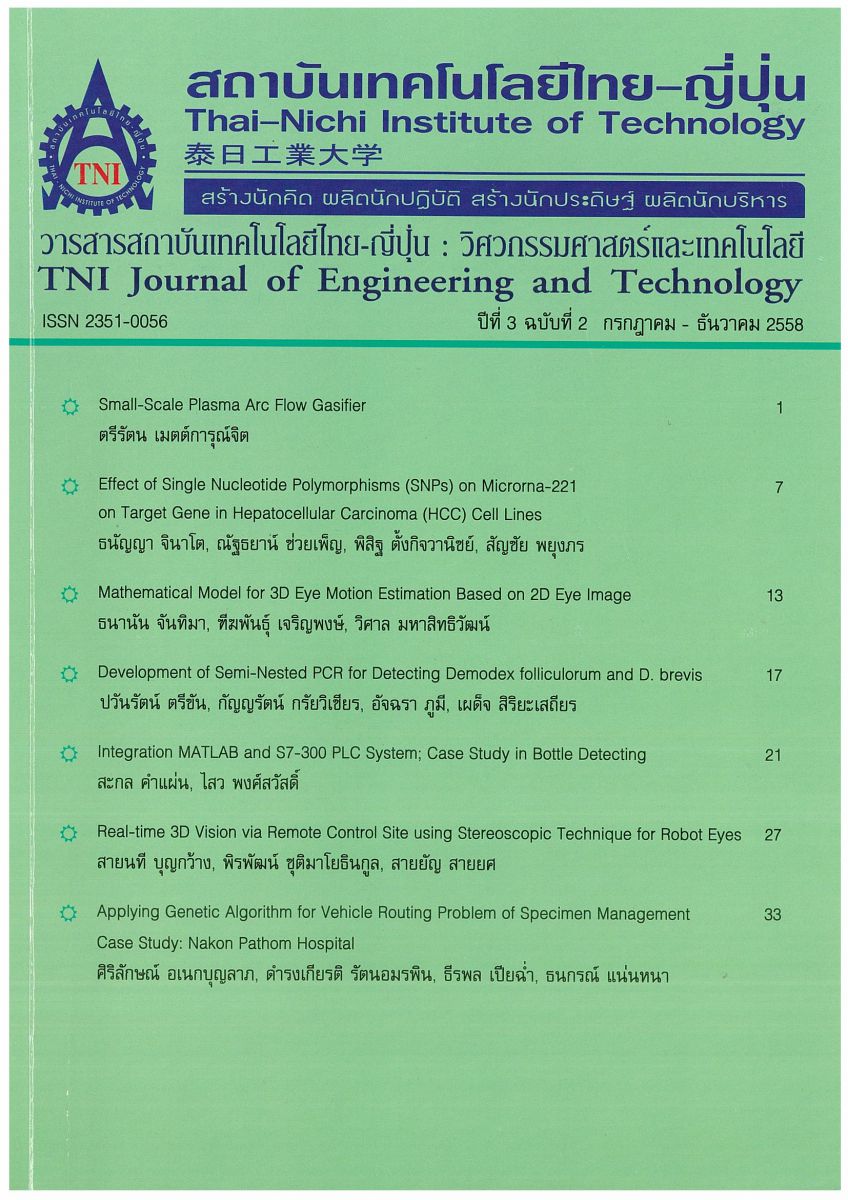Effect of Particle Size on Properties of Biocoke from Used Coffee Ground
Main Article Content
Abstract
In this research, biocoke (the solid fuel made from bio-residues) was successfully produced from used coffee ground. The effect of particle sizes of used coffee ground on properties of the produced biocoke such as bulk density, maximum compressive strength and calorific value. The particle size used as raw materials are in the ranges of 595-1,000 micron, 400-595 micron and smaller than 400 micron. It is found that the biocoke produced from the particle size in the range of 595-1,000 micron has the highest bulk density at 1.3 g/cm3, and highest maximum compressive strength at 58.54 MPa. However, the calorific values of the produced biocoke increase with the decreasing in particle size (smaller than 400 micron) has the highest calorific value at 5,175 kcal/kg.
Article Details
Article Accepting Policy
The editorial board of Thai-Nichi Institute of Technology is pleased to receive articles from lecturers and experts in the fields of engineering and technology written in Thai or English. The academic work submitted for publication must not be published in any other publication before and must not be under consideration of other journal submissions. Therefore, those interested in participating in the dissemination of work and knowledge can submit their article to the editorial board for further submission to the screening committee to consider publishing in the journal. The articles that can be published include solely research articles. Interested persons can prepare their articles by reviewing recommendations for article authors.
Copyright infringement is solely the responsibility of the author(s) of the article. Articles that have been published must be screened and reviewed for quality from qualified experts approved by the editorial board.
The text that appears within each article published in this research journal is a personal opinion of each author, nothing related to Thai-Nichi Institute of Technology, and other faculty members in the institution in any way. Responsibilities and accuracy for the content of each article are owned by each author. If there is any mistake, each author will be responsible for his/her own article(s).
The editorial board reserves the right not to bring any content, views or comments of articles in the Journal of Thai-Nichi Institute of Technology to publish before receiving permission from the authorized author(s) in writing. The published work is the copyright of the Journal of Thai-Nichi Institute of Technology.
References
Department of Alternative Energy Development and Efficiency, “Thailand Alternative Energy Situation 2013,” [Online] Available: https://www/dede.go.th/dede/images/stories/stat_dede/report13 /alternative%20energy2013%20.pdf.[Accessed: Jan. 3, 2015]
Department of Alternative Energy Development and Efficiency, “Alternative Energy Development Plan: AEDP 2012-2021,” [Online] Available: https://www.enconfund.go.th/pdf/index/aedp25.pdf. [Accessed: Jan. 3, 2015]
สำนักนโยบายและแผนพลังงาน กระทรวงพลังงาน, “ชีวมวล,” [Online] Available: https://www.eppo.go.th/engy/Load/ET08.pdf. [Accessed: Jan. 3, 2015].
International Coffee Organization., “Statistics on Coffee,” [Online] Available: https://www.ico.org/historical/2010-19/PDF/TOTPRODUCTION.pdf. [Accessed: Jan. 3, 2015].
นคร ทิพยาวงค์., “พลังงานชีวภาพ,” เทคโนโลยีการแปลงสภาชีวมวล, สำนักพิมพ์ ส.ส.ท., กรุงเทพ, 2010.
L. J. JÖnsson, B. Alriksson, N.O. Nilvebrant, “Bioconversion of lignocellulose: inhibitors and detoxification.” Biotechnology for Biofuels, Sweden, Jan. 28, 2013.
T. Sawai et al., “Compressive Strenght Properties of Bio-Solid Fuel made form Pruned Branch,” Journal of High Temperature Society, vol. 36, pp. 36-40, 2010.
Z. A. ALjubouri and A. m. ALRawas, “Physical properties and compressive strength of the technical plaster and local juss,”Iraqi Journal of Earth Sciences, vol. 9, no. 2, pp 49-58, 2009.


